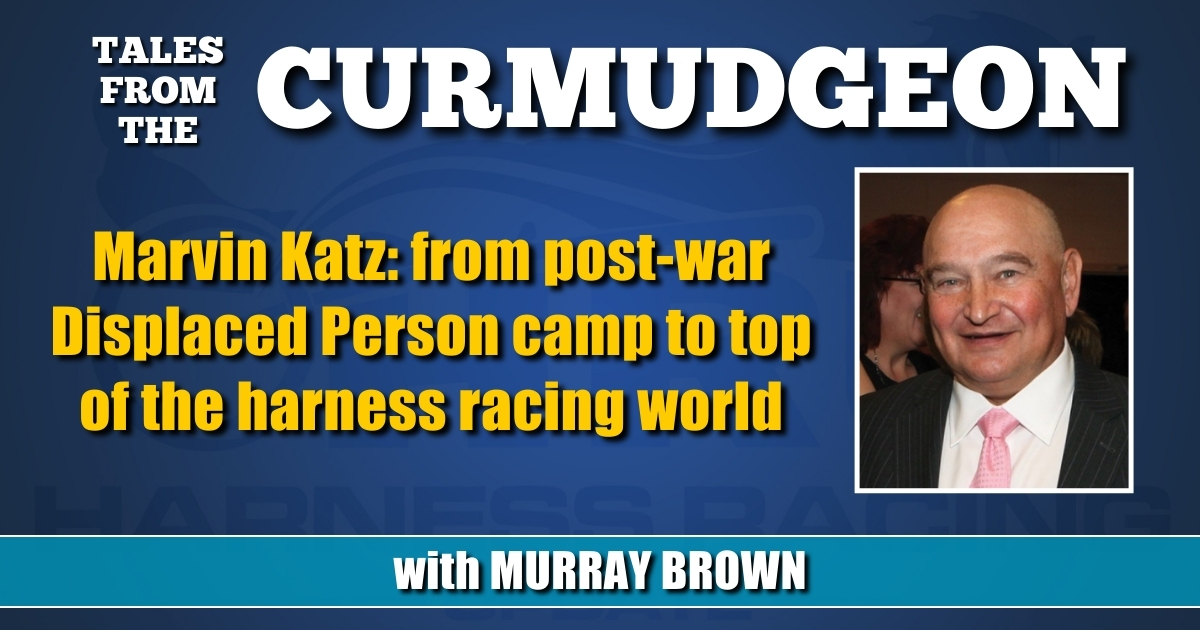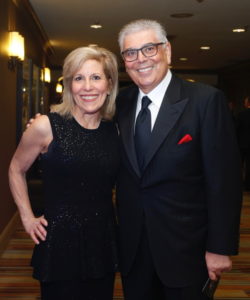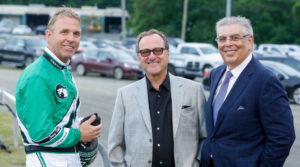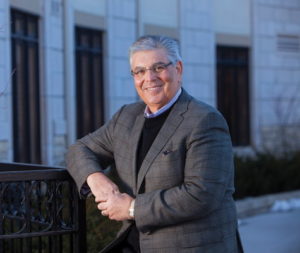Marvin Katz: from post-war Displaced Person camp to top of the harness racing world
The owner, breeder and construction magnate from Toronto has had an epic journey.
by Murray Brown
This story begins in Ulm, Germany in a Displaced Persons (DP) camp near Stuttgart. Following World War II, Europe was in shambles. There were untold tens of thousands of people who had been in the Nazi concentration camps and were scattered throughout the continent. It was in that horrible place where Marvin Katz was born to David and Marjem Katz in 1948.
The DP camps were nowhere near as bad as the Nazi concentration camps, but in their own way, they were prisons designed to keep their Jewish inhabitants from emigrating to what was to become the Jewish homeland of Israel, then Palestine — there or anywhere else.
David Katz was a trained and certified auto mechanic. Due to that expertise, he was permitted to be an ambulance driver.
It was in that camp that he met a young man by the name of Menachem Begin who was a leader of the Irgun, the most forceful of the Zionist groups seeking to establish the new state of Israel. They were considered terrorists by some — even Israelis. Their motto was “by any means necessary.” Begin was destined to become a Prime Minister of Israel and was the Israeli architect responsible for the peace deal with Egyptian leader Anwar Sadat. The Katzes and Begins, both the men and their spouses, became close friends.
As a result of that friendship, Begin had arranged for papers for the Katz family to emigrate legally to the newly-established Jewish state. However, Marjem Katz’s parents had already emigrated to Toronto Canada. As a result she insisted that the family move there as well. The move took place in 1952.
Toronto was then the second largest city in Canada behind Montreal; a city which Toronto fell behind in just about every measurable aspect — history, sophistication, size, appreciation of the arts and food. It was known as “Toronto the Good,” because the city closed down on Sundays and the bars closed at 11 p.m.
Using his ability as a mechanic as an entree, David Katz became involved in the taxi business. His first venue was located in the east end of the city, not too far from a place called Woodbine Raceway (old Woodbine, then to become Greenwood). His buddies in the taxi business often went there after the work day was over. David joined them. Although not a big gambler, David enjoyed the action and loved to bet on the horses.
David started bringing his son Marvin with him, beginning when Marvin was around the age of eight.
Marvin was smitten. He loved everything about the racetrack atmosphere. At the time, David was most enthused about the gambling aspect, but just about everything else interested Marvin. He loved watching the horses in their majesty. He studied the drivers and came to the belief that some were better or worse than others. The same of course applied to the horses. They went to both thoroughbred and harness races, but the harness horses interested Marvin most. He thought to himself that if the opportunity ever presented itself, he would become involved in this great sport.
When he first arrived in Canada in 1952, Marvin spoke German and Yiddish, but not a word of English. He quickly learned the new language and made friends in school and in the neighborhood in which they resided.
Insofar as business is concerned, Marvin describes himself as a strategic thinker and quick learner with a strong memory. Unlike Montreal, Toronto at the time had no such thing as high-rise apartment houses. Toronto was at the beginning of its uninterrupted exponential growth spurt which has continued unabated over the last half century. When Marvin was attending the University of Toronto majoring in political science, he sensed an opportunity. It was then that he began his long partnership with Sam Goldband, with whom he has been partners in construction and horses for well over 45 years.
There is the saying that from little acorns, large oak trees grow. That has been the way with their businesses. Their company the KG Group is now one of the largest independent, family-owned multi-residential management and construction businesses in Toronto. It has not been quite the same in the horse business, but it’s getting there.
I’ve known Marvin for well over 40 years and have fond recollections of he, Sam and Marvin’s dad visiting Hanover Shoe Farms in the 1970s to evaluate each year’s yearling group. As Marvin said, “Back then, I thought I knew a whole lot more than I actually did. If there is one thing I’ve learned in life, it’s that it is just as important, if not more, to know what you don’t know, than it is to know what you do.”
He currently resides in Toronto with his wife Lynn. Between them, they have a son and five daughters, plus six grandchildren. Lynn has fairly recently joined the horse owning fraternity (sorority?) becoming a partner and active participant with Marvin for several years.
Marvin, before we get to speaking about your experience in the horse business, let’s speak of an experience your family had with Menachem Begin.
“I’m guessing I was eight or nine years old. Begin, then the Prime Minister of Israel, was in Toronto for an important fundraising event. It was well publicized in the media. My dad learned that he was staying at the Royal York Hotel. He called the hotel and asked to speak with him. He was channeled through intermediaries who questioned him. He was asked to leave his number and was told that Begin might return the call. Sure enough, Begin remembered his old friend and invited my parents and I to breakfast at the hotel the next morning. I went, but I’ll admit that for the most part I didn’t really understand about any of who and what they were discussing. Many years later, Lynn and I were in Israel visiting the building where the constitution of the state of Israel was signed. I happened to mention the affiliation of Begin and my dad with an official. He took me into a room where he recorded the story. This story of my dad and Begin is now one of thousands in the archives of the country.”
How did it start for you in the horse business?
“I originally bought a horse by myself, JM Lassie, which was trained by Chris Christoforou. I quickly realized that buying and developing yearlings was more challenging and interesting than racing in overnights. Doug Arthur, the man who developed the great Cam Fella, was the first person with who I went shopping for yearlings. Doug was an excellent horseman. Most people today probably would not recognize the name, but he was an excellent judge of a horse and an exceptional horse trainer. If he were active today in the age of specialization, he would have more recognition. He drove all his horses. He wasn’t near as good a driver as he was a trainer and all around horseman. I had some good horses with Doug with whom we did pretty well. Among them were Ladino Hanover and Buster Hanover.”
Sam Goldband was with you from the beginning. You told me a couple of amusing stories about him.
“Of the trio of myself, Al Libfeld and Sam, most people look at Sam as being the calmest and most even-tempered of the three. To a great degree that’s true. But when Sam explodes, he really explodes. There are times when he has had difficulty accepting defeat.
“We were at The Meadowlands when Father Patrick was the overwhelming favorite to win the Hambletonian. As most people know, he broke right at the start. Sam was so enraged and out of control that he got up, said to his wife that he was going to the airport and going back to Toronto. His wife said, ‘You can’t do that. Our bags are still at the hotel.’ ‘Watch me’ he said and off he went.
“Dream Away had won the Meadowlands Pace and was the favorite to win the Little Brown Jug. We had a multi-million dollar stallion offer if he were to win the race. John Campbell had drives in the three eliminations of the race, but he committed to driving Dream Away in the next heat if he won his elimination. He won the elimination and drew the three hole for the final. John floated him out of there with the intent to get to the top. Everybody knows the front is the best place to be at Delaware. He took a bad step and made a break. There went the multi-million dollar deal. We were all crushed.
“Later on we were at the airport in the bar trying to console ourselves. Ronnie Pierce went by. Ron had nothing to do with Dream Away that day. Sam started laughing hysterically and said, ‘I am the luckiest guy in Ohio. If Pierce was driving Dream Away I would have killed him. But it was John Campbell. How could I kill John Campbell?’”
That story still brings a smile to Marvin’s face.
Of the three of you, Al Libfeld was the last to get involved. How did that happen?
“We had become close personal friends with Al and his wife Sheila. We’d have dinner together quite often. One time, I suggested to him that he ought to get involved in the horse business. ‘Sure,’ he immediately said. He became a great student of the game — especially trotters. I don’t think that he especially preferred trotters to pacers. But on a purely business basis, he felt that trotters represented more opportunity than pacers. Although he has had some pacers, it’s with trotters, especially trotting fillies destined to become part of our broodmare band, that he has the most interest.”
You’ve told me that you felt that for awhile you were just spinning your wheels until you became involved with Bart Glass.
“We weren’t doing well and had no real game plan and we were not enjoying much success. I didn’t know Bart, but I had heard many positive things about him. We were looking to improve our direction and find some better solutions. I called Kentucky Standardbred Horse Sales where he was the sales manager and spoke with him about the possibility of him coming to work with us as a consultant. At the time, he had several clients and was not in a position to take on a new one. Shortly thereafter, he had a vacancy and we agreed to meet. We hit it off from the beginning. From that point forward our focus was entirely on the highest quality. We started buying several top mares who had been previously been exported to Europe. An example of Bart’s influence was our purchase of Soulful Hanover. She was in the Harrisburg Mixed Sale. Bart absolutely loved her. He said we had to buy her. She didn’t have a great deal of pedigree at that time, however she has gone forward and established her own family which now includes the great Greenshoe. He was instrumental in beginning the course correction that we were seeking. Today Bart’s son, Jimmy Glass, is an integral part of our team.”
Perry Soderberg has completely revamped you broodmare band over the last decade. How would you compare him to Bart?
“They are different. Bart Glass is probably as good a livestock man as ever lived. Perry is the complete package when it comes to harness horses. He is familiar with every phase of the business as both a participant and an observer. He is a true gentleman in every sense of the word. He works exclusively for and with us and George Segal. We have a great relationship. I’m proud to call him a friend. If there is a better judge of a horse than Perry, I haven’t yet met that person. He helps us with every phase of our operation. Both Al and I can be strong willed. Perry, if needed, can act as the perfect buffer between us. He is our quarterback. Perry is responsible for the vast majority of our 70-member broodmare band. It is also he who was instrumental in establishing our relationship with Bob Brady and Kentuckiana Farms and overseeing the Libfeld Katz team operations.”
Let’s talk about some of your best known horses. Who is your favorite?
“I believe that’s an impossible question for me to answer. If I was forced provide an answer without in any way diminishing any of the other great champions with which I have been privileged to be part of, it would probably be Ariana G, probably because to that point she was the best horse bred by us. She earned just about $2.5 million, she won most of the honors she was capable of winning. But there have also been so many others.”
Okay, let’s talk about some of the other horses with which you have been associated.
Greenshoe
“We bred, raised and sold him as a yearling. I believe he had more pure speed than any horse that ever lived. He was frightening. He has everything required to become a great stallion. Pedigree, incredible ability, great conformation. I don’t see how he can miss as a stallion. When he was syndicated we invested heavily in him — both in terms of money and perhaps more importantly breeding excellent mares to him.”
Father Patrick
“A great horse. He was by far the best of his class at both 2 and 3. I believe that he is well on his way to becoming a sire for the ages.”
Captaintreacherous
“He was a colt I really liked and wanted. Perry had seen Captaintreacherous at White Birch Farms and really loved him. Myron (Bell) had bought Captaintreacherous for $250,000 the previous evening. I saw Myron the next day and congratulated him on his purchase. ‘That was a great looking Somebeachsomewhere colt you bought last night,’ I told him. Myron’s response was, ‘I’ve still got 35 per cent available, you can have it if you want it.’ I said that I’d take at least 25 per cent for myself and I’d speak to Al and see if he wants in. If so, we’d take all 35 per cent. Al said no. So the remaining 10 per cent was picked up by his breeder White Birch Farm.”
American History
“He is as perfect a racehorse as one would want to have. Myron bought him for a group that he had organized for $150,000. Then one of the original buyers backed out. Myron approached me in Florida and offered the outstanding part to me. I bought in. It has worked out very well for all of us.”
Kissin In The Sand
“A once-in-a-lifetime great pacing filly. Outstanding every season that she raced. I was deeply thrilled when she won the Breeders Crown this year. She should have won it previously but circumstances prevented that from happening. I am greatly looking forward to the foals that she and Tall Dark Stranger will produce.”
Tall Dark Stranger
“I was with Jimmy Glass at the Hunterton consignment in Kentucky. Jimmy Takter called me aside and said ,pointing to a colt, ‘That’s the best colt in the sale. You have to own him.’ ‘I’m in,’ I said. Perry had already seen him and liked what he saw. I’m obviously prejudiced, but I truly believe that he is among the greatest pacers ever. I’m thrilled that he is standing at Hanover Shoe Farms. They are making a major commitment of their best mares to be bred to him for his formative years in the stud. Those combined with the ones owned by the partners in the horse and of the quality syndicate members will assure him every possible opportunity.”
You are not much for partnerships except for close friends.
“That is still true for our primary business. Sam and I and our families are the only ones involved in the building and management businesses. Although, we have undertaken massive development projects we have done so internally without the equity involvement of outside financial institutions, pension funds, REITS which would typically participate in the type and size of developments that we undertake.
“The dichotomy is found in the multiple partnerships in which I have been a participant in racing. By its nature, it’s been a little different in the horse business. Aside from the Libfeld Katz horse partnership, the bulk of my partnership participation has been with my good friend George Segal and outstanding partners such as Bud Hatfield, Brixton Medical and several others.”
You are deeply involved in important positions in the sport other than the involvement of your own horses.
“I’ve been and am a member of the Hambletonian Society for quite some time. I’m a member of the board of directors of the Hall of Fame Museum in Goshen and also consider myself available for most endeavors that I feel will be of benefit to our sport.”
You are a big believer in giving back through charity and helping those who need it.
“We’ve been involved in charitable events in our primary business ever since its inception. We are big believers in giving back. We are trying to do the same in harness racing. The last two years at the Mohawk and Hoosier Downs Breeders Crown events we raised a significant amount of money for local charities. We will be doing the same this year for those events at The Meadowlands. We hope to raise more money than ever. We expect the industry will once again fully share with us our efforts in doing what we believe is of great importance.”
Have a question or comment for The Curmudgeon?
Reach him by email at: hofmurray@aol.com.





















